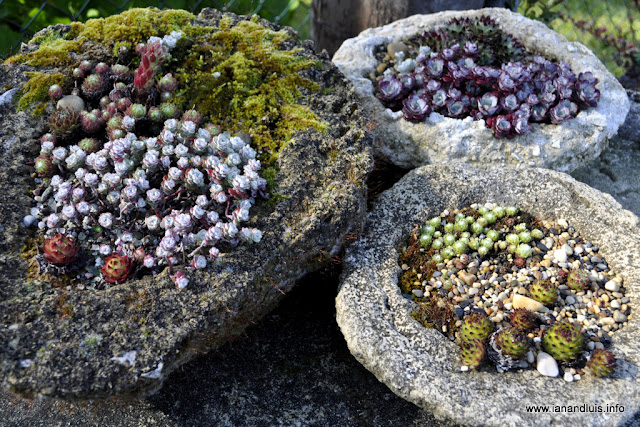Miniature gardens are special. Stand-alone microcosms with their own eco system and in the main self-reliant. Here at La Pasera we have several miniature gardens that we have created from scratch using driftwood, left-over concrete, roof tiles or broken pots.
The front boundary wall has a collection of 12 or so miniature concrete gardens all in differing stages of development and evolution. Any spare concrete we have left at the end of building work is mixed with gravel. A mould is loosely prepared in bare earth and the concrete shaped then covered with more earth. This gives the finished receptacle a residue of nutrients that encourage mosses and lichens to grow. We also insert a short piece of bamboo through the base of the pot which will be removed when dry to leave a hole for drainage. Left for a week or so in the soil they will harden after which they can be cleaned and planted.
We find succulents survive well in these shallow pots and rarely need watering. Similarly with old roof tiles, succulents work well. With roof tiles, we cement a few pebbles on at either end, fill with soil, plant and decorate with fine washed gravel.
Do you remember the piece of driftwood we collected from the beach? (story here) This has also been planted and a miniature garden created that will develop and grow over-time.
On a recent trip to town we spotted an unusual piece of studio pottery on a second hand stall, we bought it for a couple of euros with the intention of filling it with house leeks and siting it on the terrace.When we got it home, on closer inspection, we noticed a signature and date; needless to say after a bit of research we found a potter on Flickr that we think is the artist. We have sent email to him and hope he can confirm or not if he is the artist, In the meantime we will keep it safe just in case it is worth a mint (one can live in hope).
We also have a large glass bottle that we need to plant, similar to the carboys you find in the UK. Really not sure what to plant in it yet so any suggestions would be welcomed. I used to have a bottle garden many years ago until it was watered every day by an over-enthusiastic friend who was looking after the house whilst I was on holiday. Bottle gardens never or very rarely need watering after the initial setting up.
We just have the one bonsai tree but would like to grow more. We have plenty of native trees and shrubs that could be miniaturised but bonsai do take a bit more looking after than your regular miniature garden.


















































